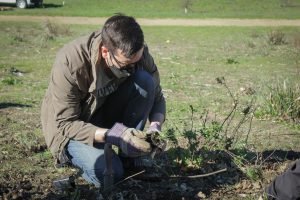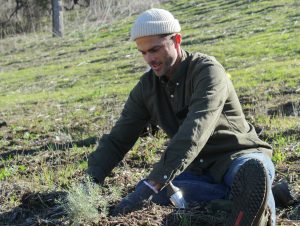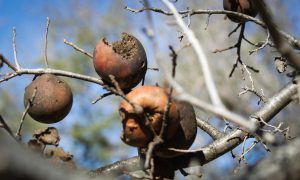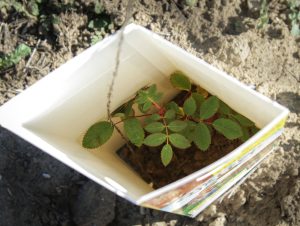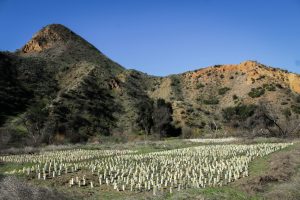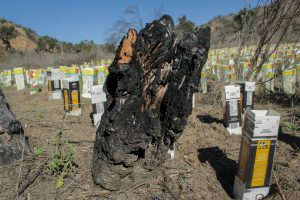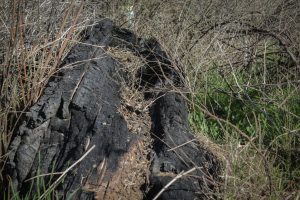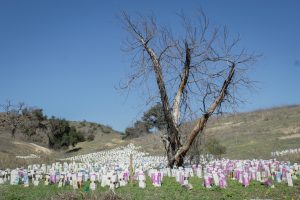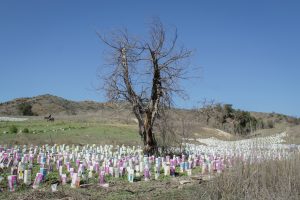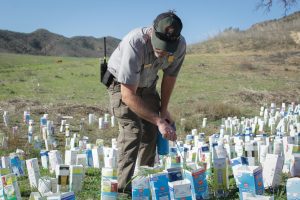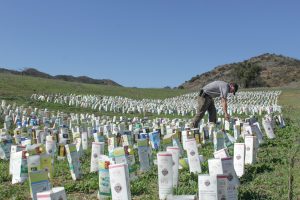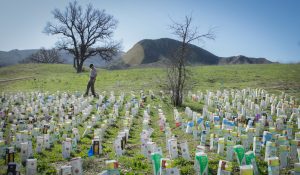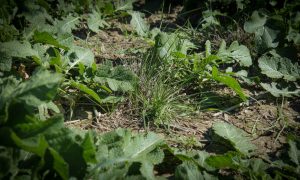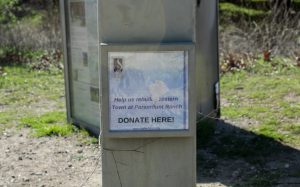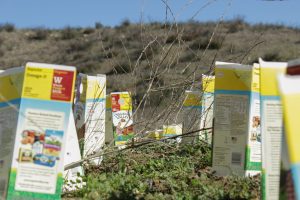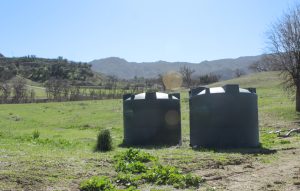- Slug: BC-CNS Wildfire Restoration Efforts, 1,235 words.
- 20 photos and captions below.
By Lauren Lively
Cronkite News
AGOURA HILLS, California – Gusting winds whipped through a charred swath of the Santa Monica Mountains, a landscape that the enormous Woolsey Fire chewed through in 2018. Twigs and broken leaves crunched and crumbled underfoot as volunteers worked on a recent Saturday to restore areas like Paramount Ranch, a working movie set that’s operated by the National Park Service to preserve American filmmaking history.
This area has been part of a multiyear restoration effort, and the National Park Service is halfway to its goal of planting 100,000 trees and plants in the Santa Monica Mountains to help restore areas like Paramount Ranch and Cheeseboro Canyon after wildfires.
“The real answer to fixing things is getting people to take action and take an interest in the natural land in their local areas,” said Joey Algiers, the restoration ecologist for the National Park Service. “Together, with large groups of people who are passionate about the same things, we can make a really big difference.”
The Woolsey Fire burned over 90,000 acres and is one of many wildfires that have devastated natural ecosystems across the West, especially California where fire seasons no longer end. The number of acres burned has increased steadily over the past three decades, according to the National Interagency Fire Center. In 2020, wildfires destroyed 10,122,336 acres across the nation, up from 4,621,621 acres in 1990.
Although the term “wildfire” suggests these fires have natural causes, the National Park Service defines a wildfire as an uncontrolled fire that was unplanned. The Congressional Research Service finds that 88% percent of wildfires from 2016 to 2020 were started by humans. That includes the Woolsey Fire, which was started by a loose wire within electrical equipment, according to state prosecutors.
After wildfires have decimated lands, ecologists have chosen to look at the bright side: In the past, invasive species have pushed native plants out of their natural ecosystems. Californian’s are learning to live with fire by replanting native species that have fire-adapted qualities, such as heat-resistant seeds and fire-resistant bark.
Although land restoration for the Woolsey Fire has been ongoing since 2019, the areas have not yet been fully restored. Even when volunteers have put 100,000 plants and trees in the ground, their job isn’t done, Algiers said. Land constantly evolves.
“You’ll come out in five years from now and 10 years from now and see trees you didn’t notice before. And in 50 years or 100 years, this could be an open woodland,” Algiers said.
Paramount Ranch was developed in 1927 as a setting for many movies, and it was taken over by the National Park Service in 1980. Now, the NPS counts on volunteers and donors to help fully restore the area.
“Everything here is project-based,” Algiers said. “We already have funding for the next two years for this particular project, and we’re constantly looking for additional funding and more partners to continue to build upon the work we’ve been doing. The park does have its own budget, but if we want to do large-scale work, we really couldn’t do as much without partners.”
Loud calls of birds erupt through the air at Paramount Ranch. Although the chatter can be mistaken for geese, it comes from tropical, nonnative birds: parrots.
The parrots aren’t the only living things here that don’t quite fit into Southern California’s ecosystem. The National Park Service says an invasive species is a nonnative organism that damages a natural ecosystem. Their impacts can be seen on the environment, on the economy and even on human health.
When deciding the “plant palette” for restoration projects – a list of species that work well within an ecosystem – NPS ecologists agreed that native species were the only way to go. Native species are important because of the way their biology works with the land. The native plants the park is reintroducing are ones that also can work with wildfires, Algiers said.
Algiers points to the invasive wild mustard plant as a prime target.
These nonnative plants live less than a year, spread very quickly and dry up very quickly,” Algiers said. “So the chances of a fire starting are much higher than in native vegetation. Native vegetation can resprout after a fire as long as they aren’t burned too frequently.”
Because native plants, such as the purple needlegrass, store more water and need less to keep hydrated, they are effective aids to wildfire prevention.
“That’s one of the problems we are seeing in our mountains, the fires are happening too often and the time between these fires is shortening,” Algiers said.
Success isn’t always guaranteed, either. About 90% of everything planted so far since the Woolsey fire has survived over two years, Algiers said.
Restoration techniques include wrapping roots in biodegradable wire materials and placing milk cartons around the plant to protect it from gusty winds and hungry herbivores. Cinder blocks also have been placed because of their durability and ability to control invasive plants.
“The milk cartons have been fantastic, I mean they work really well,” Algiers said. “They do kind of fall apart, but we reuse them as much as we can. We stake them in the ground, and once the roots have been established for a few months, we take the milk cartons off. And even if the plants get eaten, they’ll survive.”
Although protective measures are taken with new plants, these measures don’t harm the ecosystem or the species within it. One prevalent species within the Santa Monica Mountains is the gall wasp. While wasps aren’t too popular with humans, they are a big part of a full ecosystem.
“Wasps will sting and deposit their eggs onto an oak, and the oak forms almost like a tumor at the point of deposition,” Algiers said. “Then galls form and the eggs of the wasps will hatch inside.”
“This is another example of the relationship between insects and plants that are critical,” Algiers said. “We need oak trees and we need the next generation of wasps to continue because they prey on other insects and they are eaten by spiders and birds. Then the birds nest in the oak trees, and then the birds’ eggs can get eaten by snakes. Snakes get eaten by bobcats, and all these relationships can happen just because of good native vegetation.”
With the National Park Service goal to plant 100,000 plants and trees, many donors and volunteers are stepping up to make that goal possible, including Re-Plant Love, Open Hearts Foundation, Tree People, the Malibu Foundation and the city of Agoura Hills.
“About 1,500 of these oak trees were grown at a nursery and donated by Tree People,” Algiers said. “They helped plant thousands of plants and shrubs around these trees and we will be out here again next year expanding even more.”
In the three years since these restoration efforts have begun, Algiers has seen the changes the park has made and is optimistic of efforts being made in other communities as well.
“You can see stories across the world of communities coming together to clean a beach that has been littered, and they end up just being a momentum and they are able to make incredible change,” Algiers said. “I see that happening more and more with restoration and with environmental action. There seems to be a real sense of urgency and people realize that the time to act was yesterday.”
If your area has been damaged by wildfires or other disasters, check the National Park Service or other programs for volunteer opportunities.
^__=
